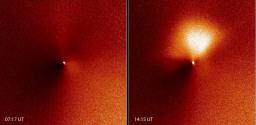An Italian astronomer has kept up an amazing spotting streak with his fifth comet in less than a year.
Andrea Boattini said he spotted the new body at sunset while he was scanning all the Near Earth Objects (NEOs) currently visible.
''While I was observing them I suddenly saw another object, moving not very fast and in rather an anomalous way,'' said Boattini, 39, who works at the Mount Lemmon Observatory in Arizona.
The comet has the technical tag P/2008 T1 but like the others has also been given its discoverer's name.
''It wasn't too hard to spot with its unusual blaze and fan-like tail,'' Boattini said modestly.
Boattini also has 170 asteroids under his belt and recently burnished his reputation further by finding the closest of those rocks to the Sun.
''It was so bright at first I thought it was a comet,'' he said.
So far some 5,000 asteroids have been spotted crossing the Earth's orbit at some point.
Only ten, on the other hand, have been found to travel inside the Earth's orbit - between the Earth and the Sun.
Boattini's discovery was the closest yet to the Sun, just 0.80 astronomical units (AUs) away.
The next two are 0.89 and 0.93 AUs from the Sun.
Boattini said the asteroid was ''large, about two kilometres across'', but does not pose a threat to the Earth.
''It's probably going to leave us in peace for a considerable length of time,'' he said.
The scientist is an expert in asteroids and comets.
He specialises in NEOs, of which there are four groups.
His latest asteroid was one of the very rare IEOs (Inner Earth Objects).
Asteroids are both bits of space rock. The main visual difference between them is that comets have a tail.
Asteroids, which are dimmer, are found in belts that orbit the Sun, while comets have larger orbits and some pop out of the Solar System.
Two of the brightest and best-known comets are the Hale-Bopp Comet and Halley's Comet.










